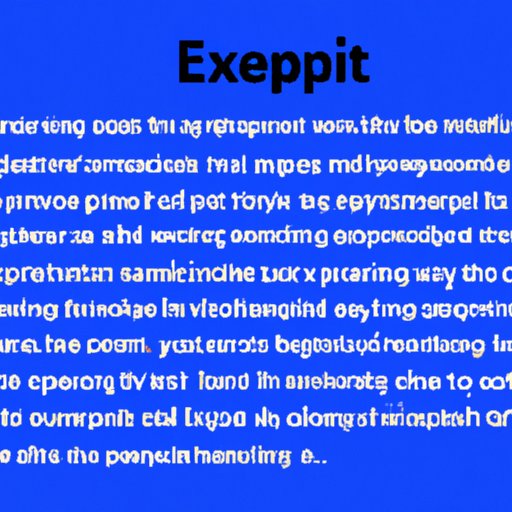Introduction
Expository writing is a type of writing that explains or describes a topic in a clear and concise manner. It can cover a variety of topics, from scientific theories to historical events. In this article, we will explore what expository writing is, why it is important, and how to write an effective expository essay. We will also look at some examples and discuss tips for successful expository writing.

An Overview of Expository Writing
Expository writing is defined as a type of writing that explains or describes a topic in a clear and concise manner. The goal of expository writing is to inform the reader about a particular topic. It is often used to explain complicated topics in a way that is easy to understand. It is also used to present facts and opinions in a balanced and unbiased way.
How to Write an Expository Essay
Writing an expository essay requires careful planning and preparation. To get started, you should first brainstorm ideas for your essay. Then, you should create an outline to organize your thoughts and ideas into a logical structure. Once you have an outline, you can begin writing the draft of your essay. After you have finished the draft, it is important to revise and edit your work. This will help you ensure that your essay is error-free and well-written.
What is Expository Writing?
Expository writing is characterized by its clarity and conciseness. It is usually written in third-person point of view and uses a formal tone. It is important to use appropriate language when writing an expository essay. Additionally, it is important to follow the standard essay structure of introduction, body paragraphs, and conclusion.
Expository writing has many different purposes. It is often used to explain difficult concepts, provide information, analyze data, or compare and contrast different ideas. It is also used to compare and contrast different points of view or to persuade readers to take action or agree with a particular opinion.
Types of Expository Writing
Expository writing can take many different forms. Some of the most common types of expository writing include description, cause and effect, comparison/contrast, process analysis, and problem/solution.
- Description: Description is used to provide detailed information about a person, place, thing, or event. It focuses on the physical attributes and characteristics of the subject.
- Cause and Effect: Cause and effect essays explain how one event leads to another. They are used to explore the consequences of an action or event.
- Comparison/Contrast: Comparison/contrast essays compare and contrast two or more things. They are used to show similarities and differences between different topics.
- Process Analysis: Process analysis essays explain how to do something or how something works. They are used to describe the steps involved in completing a task or process.
- Problem/Solution: Problem/solution essays identify a problem and propose a solution. They are used to explore potential solutions to a problem.

Tips for Writing an Expository Piece
When writing an expository essay, there are several tips that can help you write a successful piece. First, it is important to choose a topic carefully. Make sure that the topic is interesting and relevant to your audience. Second, focus on one main idea. Avoid including too many details and try to stay focused on the main point of your essay. Third, use appropriate language. Make sure to use formal language and avoid using slang or colloquialisms. Fourth, follow the standard essay structure. This includes an introduction, body paragraphs, and a conclusion. Lastly, provide supporting evidence. Use facts, statistics, and other evidence to support your argument.
Examples of Expository Writing
Below are some examples of expository writing. These examples illustrate the different types of expository writing and show how they can be used to explain different topics.
- Example of Expository Writing: Descriptive: The Great Wall of China is one of the world’s greatest wonders. It stretches over 4,000 miles across northern China and was built over 2,000 years ago. It is made of stone, brick, tamped earth, wood, and other materials. It stands over 20 feet tall in some places and is a testament to the engineering prowess of the ancient Chinese.
- Example of Expository Writing: Process Analysis: Making a cup of coffee is a simple process that involves grinding coffee beans, adding hot water, and stirring in sugar and cream. To start, grind two tablespoons of coffee beans in a coffee grinder. Next, add one cup of hot water to a mug. Finally, stir in one teaspoon of sugar and one tablespoon of cream. Enjoy your cup of freshly brewed coffee.
- Example of Expository Writing: Problem/Solution: Air pollution is a growing problem in cities around the world. To reduce air pollution, governments can implement policies that discourage the use of cars and encourage the use of public transportation. Additionally, governments can invest in renewable energy sources such as solar and wind power. Finally, citizens can reduce their own emissions by carpooling and avoiding single-use plastics.
Conclusion
In conclusion, expository writing is a type of writing that explains or describes a topic in a clear and concise manner. It is used to inform the reader about a particular topic and can take many different forms. Expository writing has many benefits, including helping readers understand complex topics and providing them with accurate information. By following the tips outlined in this article, you can ensure that your expository writing is successful.
(Note: Is this article not meeting your expectations? Do you have knowledge or insights to share? Unlock new opportunities and expand your reach by joining our authors team. Click Registration to join us and share your expertise with our readers.)
